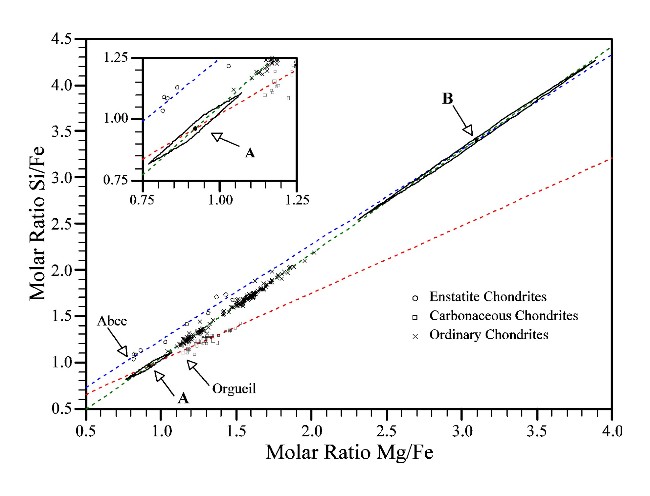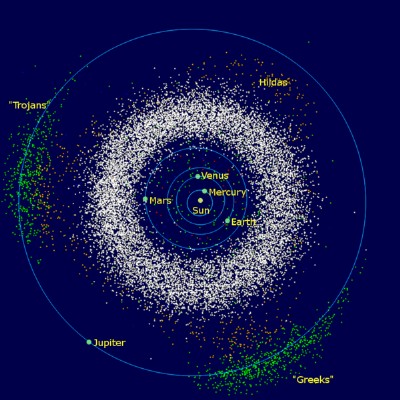

J. Marvin Herndon's Origin of Ordinary Chondrites
 
J. Marvin Herndon's Origin of Ordinary Chondrites |
Chondrite meteorites are "primitive" in the sense that their rock-forming elements occur in roughly the same relative proportion as in the photosphere of the Sun. But there are three groups of chondrites that differ considerably in their oxygen content: Enstatite, Carbonaceous and Ordinary chondrites. The latter group is so commonly observed falling to Earth that they are called "ordinary"; the other two groups are comparatively rare. Since about 1940, the idea prevailed among many that Earth resembles an ordinary chondrite, although J. Marvin Herndon has shown that below a depth of about 660 km, the Earth precisely resembles an enstatite chondrite (click here).
 Only
five elements comprise about 95% of the mass of any chondrite, iron (Fe),
magnesium (Mg), silicon (Si), and the two elements that can combine with them,
oxygen (O) and sulfur (S). For more than half a century, ordinary chondrite data
for Fe, Mg, and Si have been plotted, usually normalized to Si, occasionally to
Mg. By normalizing instead to Fe, J. Marvin Herndon discovered that published
whole-rock chondrite molar Mg/Fe and Si/Fe data plot as three well-defined lines
(see figure at right). Note that the ordinary chondrite line intersects the
other lines at points A and B. In this unique case, for the reasons explained by
Herndon [1]. ordinary chondrites can be considered a mixtures of the composition
of points A and B. This relationship admits the possibility that ordinary chondrite
meteorites are derived from two components: one is a relatively
undifferentiated, primitive component, oxidized like the CI or C1
carbonaceous chondrites (point A); the other is a somewhat differentiated,
planetary component, with oxidation state like the highly reduced
enstatite chondrites (point B). Such a picture would seem to explain for the
ordinary chondrites, their major element compositions, their
intermediate states of oxidation, and their ubiquitous deficiencies of
refractory siderophile elements.
Only
five elements comprise about 95% of the mass of any chondrite, iron (Fe),
magnesium (Mg), silicon (Si), and the two elements that can combine with them,
oxygen (O) and sulfur (S). For more than half a century, ordinary chondrite data
for Fe, Mg, and Si have been plotted, usually normalized to Si, occasionally to
Mg. By normalizing instead to Fe, J. Marvin Herndon discovered that published
whole-rock chondrite molar Mg/Fe and Si/Fe data plot as three well-defined lines
(see figure at right). Note that the ordinary chondrite line intersects the
other lines at points A and B. In this unique case, for the reasons explained by
Herndon [1]. ordinary chondrites can be considered a mixtures of the composition
of points A and B. This relationship admits the possibility that ordinary chondrite
meteorites are derived from two components: one is a relatively
undifferentiated, primitive component, oxidized like the CI or C1
carbonaceous chondrites (point A); the other is a somewhat differentiated,
planetary component, with oxidation state like the highly reduced
enstatite chondrites (point B). Such a picture would seem to explain for the
ordinary chondrites, their major element compositions, their
intermediate states of oxidation, and their ubiquitous deficiencies of
refractory siderophile elements.
 The
commonality in ordinary chondrites of a deficiency in refractory siderophile
elements suggested to Herndon that point B represents a single reservoir.
He therefore posited that the
planetary component of ordinary chondrite formation consists of planet
Mercury’s missing complement of elements, stripped from its partially
condensed protoplanet during the T-Tauri phase eruptions associated with the
thermonuclear ignition of the Sun. That stripped partially-differentiated matter
then mixed with in-falling C1/CI chondrite-like matter condensed in the outer
reaches of the solar system or in interplanetary space and formed the ordinary
chondrite parent matter mainly in the "asteroid belt" region between Mars and
Jupiter. The figure at left may be misleading; the amount of matter presently in
the asteroid belt is only about one-seventh the mass of Earth's Moon. Herndon
has estimated that the original mass of ordinary chondrite parent matter in the
asteroid belt was considerably more, about 5.5 times the present mass of Mercury
[2]. That amount of mass is insufficient in itself to form a planet as massive
as the Earth, but may have contributed significantly to the formation of Mars,
as well as adding to the veneer of other inner planets, including the Earth.
The
commonality in ordinary chondrites of a deficiency in refractory siderophile
elements suggested to Herndon that point B represents a single reservoir.
He therefore posited that the
planetary component of ordinary chondrite formation consists of planet
Mercury’s missing complement of elements, stripped from its partially
condensed protoplanet during the T-Tauri phase eruptions associated with the
thermonuclear ignition of the Sun. That stripped partially-differentiated matter
then mixed with in-falling C1/CI chondrite-like matter condensed in the outer
reaches of the solar system or in interplanetary space and formed the ordinary
chondrite parent matter mainly in the "asteroid belt" region between Mars and
Jupiter. The figure at left may be misleading; the amount of matter presently in
the asteroid belt is only about one-seventh the mass of Earth's Moon. Herndon
has estimated that the original mass of ordinary chondrite parent matter in the
asteroid belt was considerably more, about 5.5 times the present mass of Mercury
[2]. That amount of mass is insufficient in itself to form a planet as massive
as the Earth, but may have contributed significantly to the formation of Mars,
as well as adding to the veneer of other inner planets, including the Earth.
Return to Home Page NuclearPlanet.com
| References | |
| 1. |
Herndon, J. M., Discovery of fundamental mass ratio relationships of whole-rock chondritic major elements: Implications on ordinary chondrite formation and on planet Mercury's composition. Current Science, 93, 394-399. (click here for pdf) |
| 2. | Herndon, J. M., Total mass of ordinary chondrite matter originally present in the Solar System. 2004, arXiv: astro-ph/0410242. (click here for pdf) |